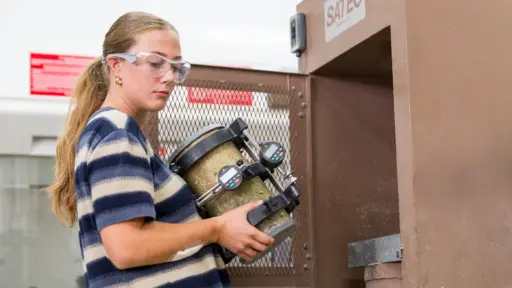A series of concrete tests that began 113 years ago at the University of Wisconsin-Madison concluded this summer, cementing a lasting legacy of research that has endured across generations.
During summer 2023, civil and environmental engineering Professor Emeritus Steven Cramer and undergraduate Ella Thomas cracked dozens of concrete cylinders that were first poured in 1923. In late July, they held open house demonstrations in the Jun and Sandy Lee Wisconsin Structures and Materials Testing Laboratory to see how the concrete withstood the test of time.
When Thomas and Cramer tested the samples with a hydraulic press, they found the century-old concrete did just that, with samples withstanding more than 8,000 pounds of pressure per square inch.
Concrete, perhaps counterintuitively, tends to get stronger as it ages. This is thanks to a process called curing, where concrete continues to draw strength from moisture in the environment. How much concrete strengthens—or if it does at all—can depend on its composition and long-term environment. When samples first poured in 1910 were crushed in 2010, Cramer said the cores left in water grew stronger, while those exposed to the air absorbed carbon dioxide and lost strength.
 A broken concrete sample during testing in the Jun and Sandy Lee Wisconsin Structures and Materials Testing Laboratory. The century-old samples withstood pressures of more than 8,000 pounds per square inch before failing. Photos by: Alex Holloway.
A broken concrete sample during testing in the Jun and Sandy Lee Wisconsin Structures and Materials Testing Laboratory. The century-old samples withstood pressures of more than 8,000 pounds per square inch before failing. Photos by: Alex Holloway.
Some of the samples have been kept in water, while others were stored in a basement in Engineering Hall. Still others were left outside and exposed to wind and rain, baking heat and brutal cold. “Today, we have ways of simulating weather, but back then, they didn’t exist, so they’d just put them outside,” Cramer said. “So these poor cylinders have been subject to our severe winters and mild winters. There are times they’ve probably been close to a sidewalk and sprinkled with salt. It’s hard to generalize other than this: despite what they’ve been through, they gained strength.”
What makes the tests unique is that, because the concrete was poured specifically for a long-range study, researchers have specifications about it—details on its mix and the composition of the cement and aggregate used—that aren’t always available for similar tests. Though concrete mixing methods have changed and improved in the century since the study began, the tests may provide some insight into how older material behaves as it ages.
The experiments began in 1910 under late engineering professor and former dean of the College of Engineering Morton O. Withey. What was initially supposed to be a 10-year experiment expanded into a 100-year project that passed on to former professors Kurt F. Wendt and George W. Washa in the 1940s, then to Cramer in 1981. After pouring the first series in 1910, further samples were created in 1923 for another 100-year test and in 1937 for a 50-year test that concluded in 1987.
Denise O’Meara and Anne Harris are cousins and Withey’s granddaughter and great-granddaughter, respectively. At the open house demonstrations, they said the experiment was something of a family legend that persisted through the generations. O’Meara’s father, who was Withey’s youngest child, even helped his father set up some of the experiments.
“My uncle went to school here, and he knew where those concrete cores were sitting for years,” Harris said. “It was part of the family lore, but I had never seen it for myself.”
 Civil and environmental engineering junior Ella Thomas loads a 100-year-old concrete sample into a hydraulic press for testing. The concrete is wrapped in sensors that measure stresses while the sample is under load.
Civil and environmental engineering junior Ella Thomas loads a 100-year-old concrete sample into a hydraulic press for testing. The concrete is wrapped in sensors that measure stresses while the sample is under load.
Thomas, a junior in civil and environmental engineering, said she and Cramer tested 30-40 concrete cores by the time of the open house demonstration, with about 120 still to go. She joined the project after learning about it through her mechanics of materials class.
“Even though I have a smallish part here at the end, just finishing up the tests, it’s been really special to be a part of it,” Thomas said. “It’s been cool to learn about the history that his project has, for UW-Madison and for everyone who has worked on it.”
That the samples made it to the finish line a hundred years later is, Cramer says, thanks to the collaborative relationships fostered within the College of Engineering.
“You can imagine two people who have a strong relationship,” he said. “But can you imagine those relationships building a chain among so many different people that lasts for 100 years? That’s pretty rich.”
Cramer plans to compile the results of the 1910 and 1923 studies for publication as a research paper.
Top photo caption: Steven Cramer, a civil and environmental engineering professor emeritus, carries a fractured concrete sample after testing it in a hydraulic press. Cramer oversaw testing the samples, which were first poured in 1923, to conclude a 100-year study. Photos by: Alex Holloway.